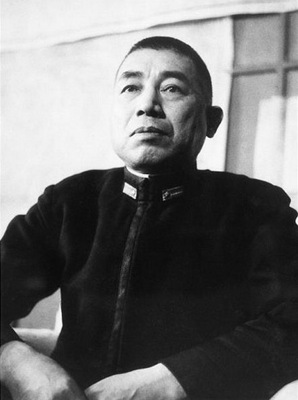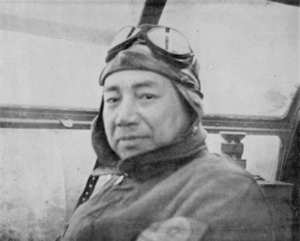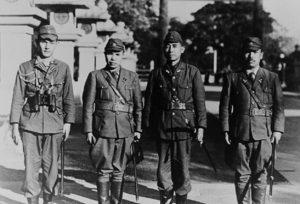Takijirō Ōnishi facts for kids
Quick facts for kids
Takijirō Ōnishi
|
|
|---|---|

Rear Admiral Ōnishi Takijirō (1939-43)
|
|
| Native name |
大西 瀧治郎
|
| Born | 2 June 1891 Tamba, Hyōgo, Japan |
| Died | 16 August 1945 (aged 54) Tokyo, Japan |
| Allegiance | |
| Service/ |
|
| Years of service | 1912–1945 |
| Rank | |
| Commands held | Sasebo Naval Air Group, 2nd Combined Air Group, 1st Combined Air Group, 1st Air Fleet, Vice-chief of Navy General Staff |
| Battles/wars | Second Sino-Japanese War
|
Takijirō Ōnishi (大西 瀧治郎, Ōnishi Takijirō, born June 2, 1891 – died August 16, 1945) was an admiral in the Imperial Japanese Navy during World War II. He is often remembered as the "father of the kamikaze" because of his role in creating these special attack units.
Takijirō Ōnishi was born in a village called Ashida, which is now part of Tamba City in Hyōgo Prefecture, Japan. He joined the Imperial Japanese Navy Academy and finished his training in 1912. He was a good student, ranking 20th in his class of 144 cadets.
After graduating, he served on several ships, including the cruiser Soya and the battleship Kawachi. He became very interested in naval aviation, which was a new and exciting field at the time.
Ōnishi helped develop the Imperial Japanese Navy Air Service. He even traveled to England and France in 1918 to learn more about how other countries were using combat aircraft in World War I. When he returned, he continued to work with naval aircraft and even taught flying lessons.
He rose through the ranks, becoming a lieutenant commander and then a rear admiral. He commanded the air wing on the aircraft carrier Hōshō and later became the executive officer of the aircraft carrier Kaga. By 1939, he was the chief of staff for the 11th Air Fleet.
Role in World War II
At the start of the Pacific War in World War II, Ōnishi worked in the Ministry of Munitions. He helped with some of the technical plans for the attack on Pearl Harbor in 1941. Interestingly, Ōnishi himself did not think the attack on Pearl Harbor was a good idea. He believed it would lead to a long war with the United States, a country with many more resources than Japan. He worried Japan would have to surrender completely.
Despite his concerns, his 11th Air Fleet played a key role in attacking American forces in the Philippines from Taiwan. In 1943, he was promoted to vice admiral. Ōnishi was also very interested in how soldiers reacted under stress. He even wrote a book about it in 1938 called War Ethics of the Imperial Navy.
Later in the war, after October 1944, Ōnishi became the commander of the First Air Fleet in the northern Philippines. As the war turned against Japan, and with orders to destroy the US Navy's aircraft carriers, Ōnishi changed his mind about the best way to fight. He then ordered the first kamikaze attacks.
He spoke to the first kamikaze unit, telling them that their brave spirit would save Japan, even if they lost the war. Kamikaze were special attack pilots who would intentionally crash their planes into enemy ships. After this, Ōnishi was called back to Tokyo and became the Vice Chief of the Imperial Japanese Navy General Staff in May 1945.
Just before the war ended, Ōnishi still wanted Japan to keep fighting. He believed that if 20 million more Japanese people sacrificed their lives, Japan could still win.
Death and Legacy
After Japan surrendered in August 1945, Takijirō Ōnishi took his own life. He did this as a way to apologize to the kamikaze pilots and their families for their sacrifices. He wanted his death to be a penance for them.
The sword he used is now kept at the Yūshūkan Museum in Yasukuni Shrine in Tokyo. His ashes were divided and buried in two places: one at a Zen temple called Sōji-ji in Yokohama, and the other in a public cemetery in his hometown in Hyōgo Prefecture.
In Film
Takijirō Ōnishi has been shown in several movies:
- The Japanese actor Tōru Abe played Ōnishi in the 1970 film Tora! Tora! Tora!.
- He was also in the 1970 film Saigo no Tokkōtai (The Last Kamikaze), directed by Junya Sato.
- In 1974, Toei made a movie about his life called Ā Kessen Kōkūtai (Father of the Kamikaze), directed by Kōsaku Yamashita.
See also
- Kamikaze
 In Spanish: Takijirō Ōnishi para niños
In Spanish: Takijirō Ōnishi para niños




